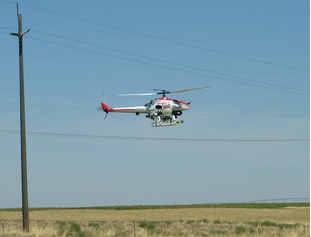Pendleton, home of the Pendleton Roundup, held a very different type of rodeo August 18-19. The first Pendleton Ag Drone Rodeo shared at least one trait with traditional events such as the Pendleton Roundup that started more than a century ago: It showcased activities that can be useful to farmers and ranchers. But the similarities end there.
Rodeos first stamped their place in American history when agriculture relied almost exclusively on manual labor. The Pendleton Roundup started in 1910 in the early days of agricultural mechanization. The drone rodeo reflects the latest way technology has transformed how field crops are grown and animals are bred and raised. Drones, also known more technically as unmanned aerial systems (UAS) or unmanned aerial vehicles, could kick agricultural efficiency to a new level – literally and metaphorically.
On the first day of the drone rodeo, companies gathered at a potato farm to demonstrate how unmanned systems with advanced sensors could be used for tasks such as precision spot spraying at a potato farm. On the second day, participants gathered at the Oregon Army National Guard Armory at the Pendleton Airport to review and interpret the data collected.
Agriculture is just one industry that hopes to use unmanned aerial systems to develop more efficient production techniques and reduce costs. And just as Oregon’s agriculture industry is known for its crop diversity, Oregon is in position to be a leading player in several sectors of the emerging, rapidly growing drone industry.
About a dozen states have federally approved test sites, and Oregon is home to three, each offering different climates and topographies: One in Pendleton, another on the Warm Springs Reservation and one based in Tillamook on the Oregon Coast. Oregon State University is one of 22 universities participating in the Alliance for System Safety of UAS through Research Excellence, or ASSURE. The statewide nonprofit SOAR Oregon was created in 2014 to promote economic development of the UAS industry in Oregon. Industry pioneer Insitu, though located across the Columbia River in Washington, helped attract a cluster of drone-related businesses to the Oregon side of the Columbia in the early days of the industry.
The first Pendleton Ag Drone Rodeo gave companies an opportunity to demonstrate how drones can be used in agricultural operations. Digital Harvest’s Yamaha R-MAX, shaped like a manned helicopter, simulated how
herbicide could be applied in a precise pattern mapped using a combination of satellite, drone and ground sensor data.
Oregon also has support industries that are important to the development of UAS-related businesses. Jonathan Evans, chief executive officer, of Skyward, a Portland drone software and services company, explained the state’s corporate advantage in an article for the Portland Business Journal: “Oregon is uniquely positioned at the confluence of aviation and computer hardware – which is what an aerial robot is. Helicopter companies Erickson, Columbia Helicopters and Helicopter Transport Services are all based in the Portland metro area. On the hardware side, we have Intel Corporation, whose CEO Brian Krzanich sits on the FAA’s Commercial Drone Alliance.”
With all of this in its favor, Oregon has attracted companies that incorporate drone use into a number of business activities: agriculture, construction, forestry, photography and site inspections to name a few. The state’s test sites also are playing a role in developing drone technology that can be applied to public services such as disaster response and public safety.
Oregon’s UAS industry is diverse in another important way: It has the potential to help different parts of the state. The test ranges are on the Coast, in the Columbia River Gorge and in Central Oregon. Skyward is based in Portland, while agricultural mapping company OmniFox Aerial Images operates out of Milton-Freewater. SOAR Oregon’s offices are in Bend. Agricultural and forestry operations in rural Oregon stand to be some of the biggest beneficiaries of UAS technology.
Of course, Oregon is not the only state eager to capitalize on this growing industry. Eventually, the FAA will approve more test sites, technology will evolve and Oregon’s advantages could diminish unless the state uses its head start effectively.
Disclaimer: Articles featured on Oregon Report are the creation, responsibility and opinion of the authoring individual or organization which is featured at the top of every article.




